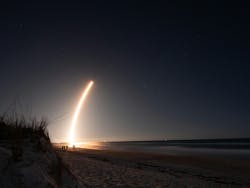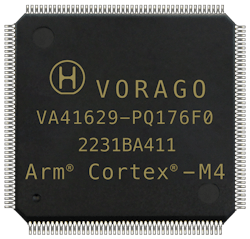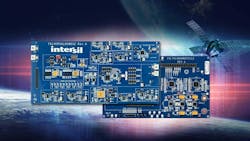Radiation-hardened branches out from New Space
Summary points:
- New Space is driving demand for cost-effective, radiation-tolerant electronics by favoring design trade-offs such as plastic-packaged components, redundancy, and software voting instead of traditional, costly radiation-hardened parts to meet low-Earth orbit (LEO) mission needs promptly and affordably.
- Suppliers and spacecraft designers are expanding their focus beyond Low Earth Orbit (LEO) to Medium Earth Orbit (MEO), Geosynchronous Orbit (GEO), the Moon, Mars, and deep space, prompting a need for more flexible electronic component strategies that blend radiation-hardened and radiation-tolerant technologies.
- Companies like Renesas, Spirit Electronics, and Vorago Technologies are offering scalable solutions, including flexible packaging grades and architecture that supports both rad-hard and rad-tolerant parts, to meet diverse mission profiles and reduce costs and design time.
NASHUA, N.H. - Technologies for enabling electronic components to survive the radiation environment of space are evolving beyond today's demand for affordable electronics for low-Earth-orbit satellites, as spacecraft designers look beyond commercial satellites toward future moon, Mars, and deep-space missions.
While historic technologies for radiation hardening have involved expensive and rugged ceramic packaging and special bottom-up designs to ensure performance in the naturally occurring radiation of space, recent years have seen a shift in emphasis from radiation-hardened to radiation-tolerant processors, power controllers, and other electronic components.
The primary market driver from radiation-hardened to radiation-tolerant electronics has been so-called "New Space," in which satellite lifetimes are shortened, and designers are as concerned with overall costs and time to market as they are with reliability in space.
How to achieve radiation tolerance that is affordable and good-enough for low-Earth-orbit satellites can vary. Systems designers often substitute affordable plastic-packaged integrated circuits for bullet-proof and expensive ceramic parts. SpaceX, for example, often relies on triple-redundant parts to ensure spacecraft performance even if one or two components fail.
These kinds of design tradeoffs essentially have defined the New Space market now for several years, as commercial satellite constellations are sensitive to costs and fast delivery schedules. Solutions can involve redundant plastic-packaged parts, special shielding for sensitive components, software voting schemes to keep functions working amid radiation strikes, and a battery of tests and upscreening to choose the most reliable commercially available electronic parts.
"There's been more of a call to action in the last year or two, based on the success of SpaceX in low-Earth-orbit," says Josh Broline, senior director of strategic marketing and applications engineering at rad-hard specialist Renesas Electronics America in Palm Bay, Fla. "We're asking, is there more of an opportunity to use radiation-tolerant or automotive parts for these applications? Various companies are going at that challenge different, based on what SpaceX has put out there."
Beyond New Space
Yet spacecraft designers and rad-hard electronics suppliers are looking beyond New Space to encompass applications like medium-Earth-orbit (MEO), high-attitude geosynchronous orbit, and beyond Earth orbit like deep-space probes and future missions to the moon and Mars.
"New Space is a piece of the rad-hard market," Renesas's Broline explains. "There are six market segments: U.S. government, NATO, other governments, commercial GEO, and New Space. GEO and MEO is in that mix."
Broline says additional rad-hard space markets are emerging, such as non-terrestrial networking and direct-to-device applications like satellite signals that go directly to cell phones without using land-based cell towers. "Those applications are attaching themselves to New Space, as well," Broline says.
Each market segment has different requirements, and has different electronics on-board, Broline says. "As direct-to-mobile applications gain more traction, they basically outfit their satellites to do multiple functions. One of the main thrusts of LEO is to reduce latency so as to do streaming, voice, and data. But in reality you need more satellites, and it becomes a very capital-intensive endeavor; it fits really well into the MEO and LEO markets.
New Space finds itself among two camps in the space market, says Sean MacDonald, director of technical sales at Spirit Electronics in Phoenix, a specialist in electronics upscreening and testing for space applications.
"We have the historical primes, who have a legacy mindset," MacDonald says. "Those processes take a long time. Now we have the New Space market that is moving really fast. Now the primes are trying to figure out how to compete in the same market as these Tier 2 and New Space players. The primes want to move as quickly as the New Space market does, and they need a third party to do that."
Each market has its own attributes. "In the New Space camp we are seeing a focus on more integration," MacDonald says. "People are out there buying subsystems and modules, instead of developing them themselves. It is opening the door to subsystem and module providers who are ready to bring this to the New Space market."
Make-versus-buy
Component manufactures have room to move in this market, he continues. "It is a make-versus-buy decision. They want to buy it and get to space as quickly as they can. People have leaned on FPGAs [field-programmable gate arrays] to drive and power their devices. Now a lot of people look at building their own FPGAs and do custom work. Chip foundries are opening up and becoming more accessible. As soon as you can own and manage your supply chain, it becomes much more palatable to make your own devices; on the subsystems and modules, people want to buy, but in FPGAs people want to design their own."
These conditions will expand the number of players in the New Space market -- especially at the component level," MacDonald says. "Then more of them will wake up and realize space is where they want to play."
As the space market increases in popularity, electronic component designers are looking for new ways to get the most out of space applications across the board. "Most companies out there are looking for something in the middle, between radiation tolerant and more commercial-like," says Renesas's Broline. "We are trying to meet that trend with multiple flows of plastic and ceramic. We have three different grades, and have introduced the ability to meet different mission profiles, from LEO or military at GEO, or the moon and Mars."
This is driving a coalescence of New Space and beyond orbital space applications. "New Space historically is about people getting their satellites in space, especially in the LEO orbit," says Spirit Electronics's MacDonald. "It's been about getting satellites in space and proving your technologies can survive. Now it's more business-case-centric."
That is, rad-hard suppliers are trying to cover a broader segment of the market than simply New Space. "In the past year, we've seen a shift where people want to get to MEO and GEO orbits. There also are lot of lunar applications coming up for mining on the moon," MacDonald says. "The market will expand, and will become space, not just new space."
In fact, MacDonald says he sees in the future that commercial space communications will become nearly an exclusive domain of private business like SpaceX, while NASA and the U.S. Space Force will focus on high-altitude, more-difficult missions.
The SpaceX turning point
"SpaceX is the turning point in my mind," MacDonald says. "They reduce the launch costs and it opens the door to a lot more experiments you can run and prove out your science. NASA, AFRL [the Air Force Research Laboratory], and the Space Force will shift their focus to bigger and better things, like the next big thing, in moon shots, and the other companies will focus on space as a business. NASA will focus on deep space and laboratories in space; that's what NASA will see more work in."
One approach that electronics suppliers are taking to broaden the markets they serve is to combine radiation-hardened and radiation-tolerant parts in one architecture. "We offer as much flexibility between rad-hard and rad-tolerant as we can," says Ken Obuszewski, vice president of business development and products at Vorago Technologies in Austin, Texas.
"Customers like mission flexibility," Obuszewski continues. "They need something that could scale across all orbits, so you don't have to invest in multiple platforms, and make one investment in hardware and software. Space X builds in triple redundancy; they also are willing to have satellites fail. Most new-space folks really can't take that risk so they have to balance the right level of reliability."
Vorago, a specialist in designing semiconductors and special electronics packaging for radiation environments, is seeing success with deploying the company's HARDSIL technology in different wafer fabs. We enable our radiation-hardened technology and apply it to industrial and robotics applications," Obuszewski says.
"What will really be of value, and what we will be enabling, is to support rad-hard and rad-tolerant in the same architecture so our customers don't have to double their investment in the two designs," Obuszewski says. "Once HARDSIL is deployed there, you don't have to redesign the parts; you can have rad-hard and rad-tolerant coming of the same line at once."
HARDSIL is a process enhancement to standard Bulk CMOS manufacturing that hardens devices against the effects of radiation and temperature. HARDSIL can be used to harden any CMOS device using standard manufacturing equipment with no negative impact on performance or yields. This approach is a cost-effective alternative to current high-reliability techniques that use specialized manufacturing techniques, up-screened commercial products, redundant systems, or exotic packaging.
Not only can HARDSIL help manufacture electronic parts with several different resistances to radiation, but the technology also can apply to some of the latest and most advanced semiconductor technologies, such as general-purpose graphics processors (GPGPUs) for high-performance parallel processing in space, or in any other applications that could be susceptible to radiation.
"We see coming, with so many autonomous life-critical applications coming, these device will be more and more susceptible to ground-level radiation," Obuszewski says. The ability to protect those devices will become very critical."
Beyond Earth orbit
A renewed NASA emphasis on space exploration beyond Earth is creating limited-yet-growing demand for electronic parts with super-rugged resistance to space radiation. Several NASA projects are in progress for exploration missions to the moon, Mars, and Jupiter's moon Europa.
"The moon is closer to a GEO orbit for defending against total ionizing doses, and is closer to GEO," Renesas's Broline says. These high-altitude geosynchronous-orbit spacecraft are subject to much higher exposure to space radiation than is low-Earth orbit, where the Earth and its atmosphere can provide some protection from radioactive charged particles.
Future missions to Mars will increase exposure to radiation further still. "Mars is a much different ball game from geosynchronous or lunar missions," Broline continues. "There was a study recently that says humans could only survive on Mars with infrastructure built below ground, or using very thick walls, if you have infrastructure on the surface. These are harsh environments. If we were to colonize the moon, they would need the appropriate infrastructure."
Broline points out that Renesas has provided electronic parts to every space rover sent to the moon and Mars. "These parts will have many years of survivability without additional shielding, and have met the requirements there."
Missions beyond Mars likely will require even more resistance to space radiation than do geosynchronous or moon missions. The NASA Europa Clipper space probe, launched last October to conduct a detailed study of Jupiter's moon Europa, requires protection to 300 kilorads of total-dose radiation, which is three times what is necessary for Mars.
Europa Clipper will travel 1.8 billion miles to reach Jupiter in April 2030. The spacecraft will orbit Jupiter, and conduct 49 close flybys of Europa. The spacecraft carries nine science instruments, and a gravity experiment that uses the telecommunications system. All science instruments will operate simultaneously on every pass.
"Beyond Earth is an important market segment," says Renesas's Broline. "It takes quite a while to get hardware launched, and is an add-on type of market. It's not necessarily driving our decisions on a daily basis. Sometimes you need shielding, or put a particular component deeper on the satellite, but it's still an important segment."
About the Author
John Keller
Editor-in-Chief
John Keller is the Editor-in-Chief, Military & Aerospace Electronics Magazine--provides extensive coverage and analysis of enabling electronics and optoelectronic technologies in military, space and commercial aviation applications. John has been a member of the Military & Aerospace Electronics staff since 1989 and chief editor since 1995.




